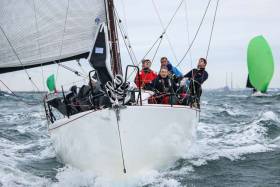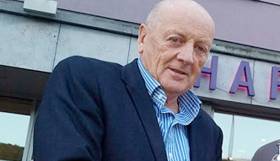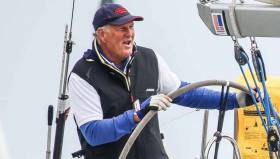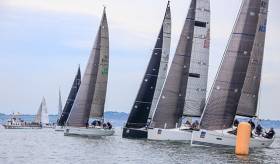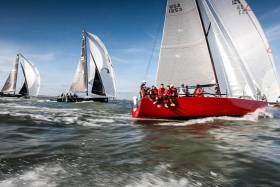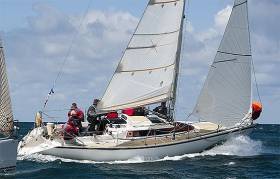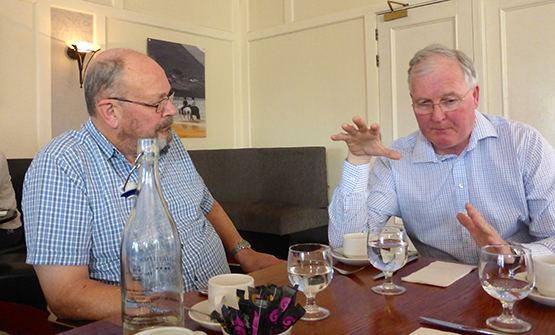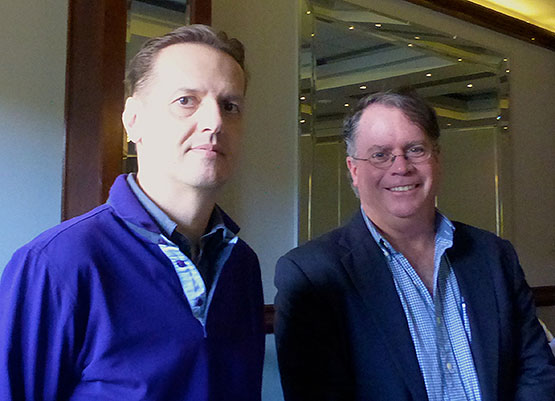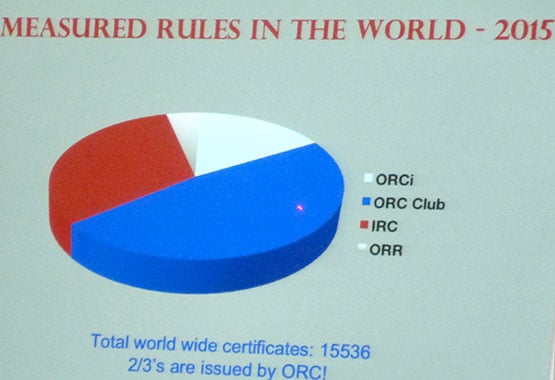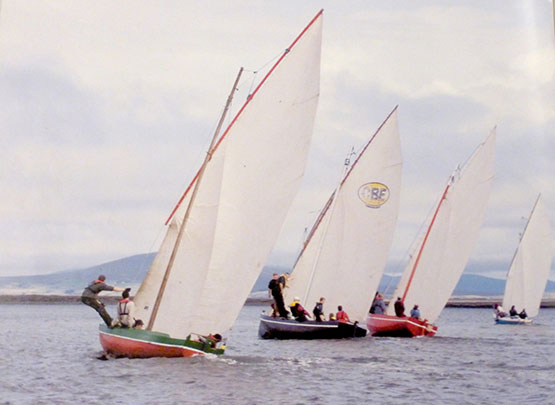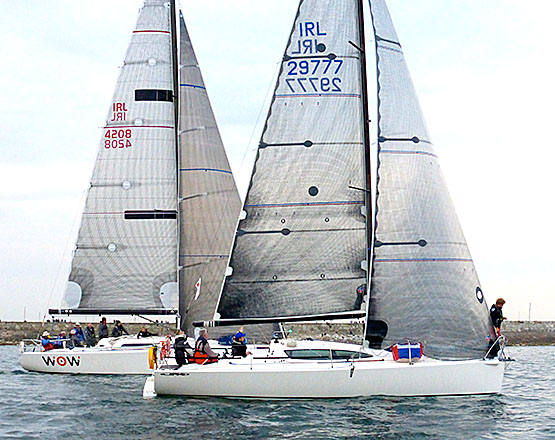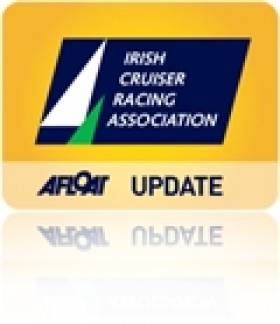Displaying items by tag: Irish Cruiser Racing Assocation
Rockabill VI Leads ICRA Boat of the Year Standings
The end of June meant the Irish Cruiser Racing Nationals (ICRA) Boat of the Year standings has begun to take shape.
As Irish Times Sailing Correspondent David O'Brien reported last Friday, as a result of class victory at the Irish Cruiser Racing Nationals on Dublin Bay last month plus a successful defence of the Dun Laoghaire to Dingle Race, also in June, Paul O'Higgins's Rockabill VI was the runaway leader of ICRA's reformatted Boat of the Year award at the halfway stage of the competition.
A national title and Irish Half Ton Cup victory have placed Mata (Wright Brothers) at number two on the rankings, whilst a national title and second place at the Sovereign's Cup is enough for white sails’ ace, Demelza to slide in at No. 3.
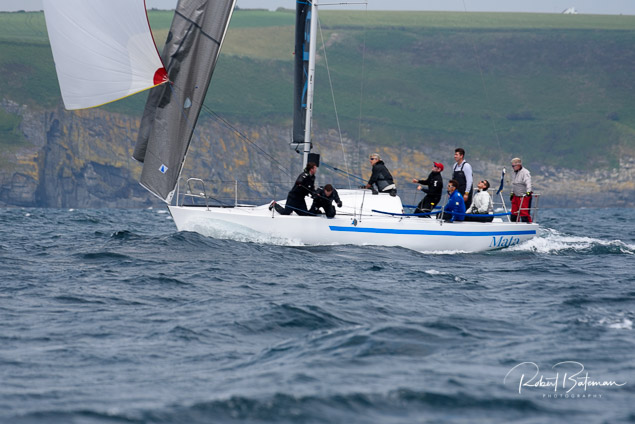 Mata Photo: Bob Bateman
Mata Photo: Bob Bateman
A busy month for the J109 Outrajeous has placed them in fourth, narrowly ahead of national inshore champions Dux, Joker II, and Supernova, and D2D division winners Indian and Red Alert.
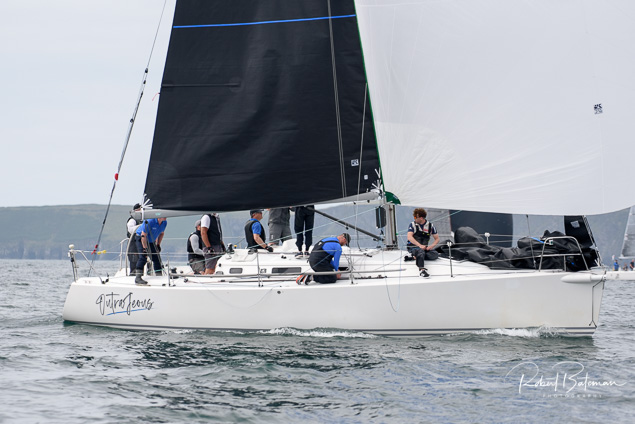 Outrajeous Photo: Bob Bateman
Outrajeous Photo: Bob Bateman
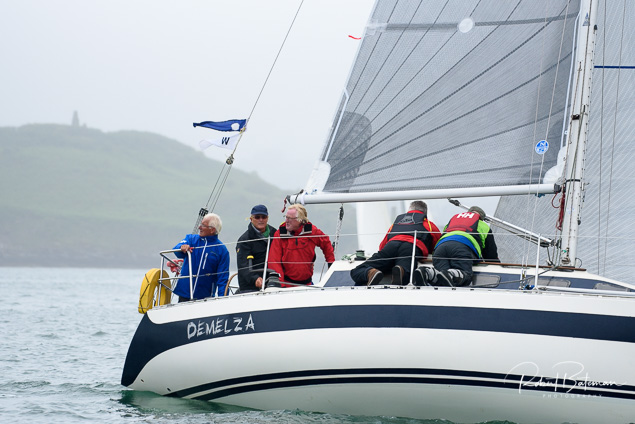 Demelza Photo: Bob Bateman
Demelza Photo: Bob Bateman
 Dux Photo: Afloat
Dux Photo: Afloat
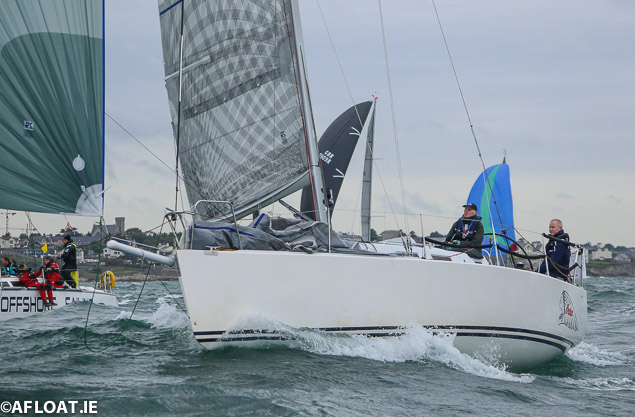 Indian Photo: Afloat
Indian Photo: Afloat
 Red Alert Photo: Afloat
Red Alert Photo: Afloat
Download the current standings below
There’s a lot of racing still to go. July and early August, featuring the Dun Laoghaire Regatta, WIORA Championships and Round Aran race in the west together with the second counting ISORA offshore, before the autumn will bring results to count from the DBSC season, HYC Autumn League and RCYC October League. While Rockabill VI currently sits on top of DBSC Class 0 and will be a favourite for the ISORA race to Pwllheli if she enters, Demelza and Mata have the HYC Autumn League to go. All three are entered for the Dun Laoghaire Regatta and will be amongst the favourites for their divisions.
ICRA updated its Boat of the Year scheme this year to better reflect the national cruiser-racer picture. Now, instead of an annual committee decision, the points from a series of 12 regattas will be combined to identify the top performing boat on IRC across the season balanced between the east, south, west and offshore scenes.
The ICRA Boat of the Year is now awarded on a points basis with the top three places in an IRC division at National Championships. National regattas and regional events all count towards the rankings for the year. At the halfway point, no less than 58 boats have made their mark.
Download the current standings below
Nobby Reilly Details Decision To Resign From ICRA
#ICRA - Norbert ‘Nobby’ Reilly has spoken to Afloat.ie to clarify his comments over his resignation from the Irish Cruiser Racing Association (ICRA) last week.
As previously reported on Afloat.ie, the Howth Yacht Club sailor and former ICRA commodore left the organisation on the eve of a crucial symposium at the weekend to decide its future, citing disagreements with its direction over the previous year.
Among these were claims that little of its funding boost since signing a memorandum of understanding with Irish Sailing went to new training programmes or recruitment of new members.
Reilly also referred to the decision to make Galway the host venue of the 2018 ICRA Nationals was not passed by the executive, and that the first he learned of it “was on Facebook”.
Commenting to Afloat.ie on Friday, IRCA commodore Simon McGibney said that Reilly had been given a fair hearing regarding his complains, adding that decisions “are always done by majority”.
But Reilly has hit back at assertions that there is “democracy” in the organisation, claiming that no minutes of meeting have been produced where Galway was agreed as this year’s venue.
Following the announcement, Reilly says there was “a storm of protests” from Dublin-based cruiser racers.
A survey was sent out to all members to gauge whether or not they sailed in the 2017 ICRA Nationals at the Royal Cork, the results of which have yet to be officially published.
“All summer ICRA received emails and calls protesting about Galway,” adds Reilly. “I requested that same be made available to [the] ICRA exec but reply received [was] “These were personal to the commodore.’”
Reilly says there was a push within the organisation for an EGM to review the danger of becoming irrelevant to the Dublin fleet, which constitutes the majority of IRCA’s membership.
Instead, a full executive meet was arranged, but Reilly claims that its members had not all been made aware of the complains from the Dublin membership, and that the resulting meeting only saw 50% attendance.
Reilly says his pitch to the executive that IRCA talk with Galway with a view to keeping Dublin as a host venue for the 2018 calendar was voted down — and he was further shot down over his request that Dublin keep a slot by running an East Coast IRC.
“The exec in ICRA is just irrelevant,” adds Reilly on his decision to resign. “Recently two new members [were] added with no discussion or prior notice.”
Royal Cork's Mansfield Is Tactician on Winning J109 at Warsash Spring Championship Weekend
The first large regatta weekend of the year in the Solent is the Warsash Spring Championships weekend held over two weekends, the 8th and 9th of April and the 22nd and 23rd April.
Each weekend is Individually counted with an overall prize, plus an overall between result counting the two weekends.
Mark Mansfield, from Royal Cork, was calling tactics on John Smart's J109 Jukebox in the competitive J109 one design class. Five races were sailed in mainly 10–14 knot conditions and Jukebox ended with a 1,1,1,2,4 scoreline to take the first weekend by nine points over their next rival.
Mansfield has considerable J109 experience as he calls tactics on John Maybury's Joker II who is the 2016 ICRA Boat of the Year having regained her ICRA class one crown in 2016 previously won in 2015. He also sailed aboard David Cullen’s Euro Car Parks, also a J109, when she won her class in the 2016 Round Ireland Race.
More here
ICRA Surveys Members on Howth Yacht Club Championships
Following its national championships at Howth Yacht Club in June, the Irish Cruiser Racing Association (ICRA) is seeking feedback on the event via an online questionnaire.
ICRA commodore Simon McGibney says the survey aims to get views on how the event went for attendees but it also seeks the views of non attendees. The survery can be taken here
The next ICRA National Championships take place in at the Royal Cork Yacht Club in 2017
It has been confirmed by the Irish Cruiser-Racing Association (ICRA) that it’s extremely unlikely that Ireland will be mounting a defence in July 2016 of the RORC Commodore’s Cup, which we so convincingly won in 2014 with the team of Catapult, Antix and Quokka 8. Apparently the defence has foundered on the difficulties of finding a person or group willing to take on the campaigning of a third boat which would be suitable to back up Anthony O’Leary’s 2014 Ker 40 Antix (ex-Catapult), and Michael Boyd’s new JPK 10.80. Michael Boyd and Anthony O’Leary had lined up a possible charter of Quokka 8 on a speculative (and expensive) retention fee in the hope that a team of optimal make-up could take shape, but no-one has proved willing to take up the costly full-charter option to make her the third boat. W M Nixon reflects on this unhappy follow-up to a good news story which helped lift Ireland out of the gloom of the recession in 2014.
The Commodore’s Cup 2016 as a Sail Training exercise? It’s one of the less crazy scenarios which is emerging from the conclusion that a realistic and highly-powered defence of Ireland’s 2014 win is simply not on the cards. The word is that the two front-line boats have been unable to find people with mega-resources and a crew willing to take up the third slot with Quokka, or possibly another boat altogether. Thus all bets are off.
To outsiders, it all sounds like a bit of the old hissy-fits, and more. Surely something could have been done? But those who have been in the midst of the Commodore’s Cup cauldron have some idea of both the stress involved (which is huge at the front of the fleet), and just how very much it is more important than ever to have a finely balanced team.
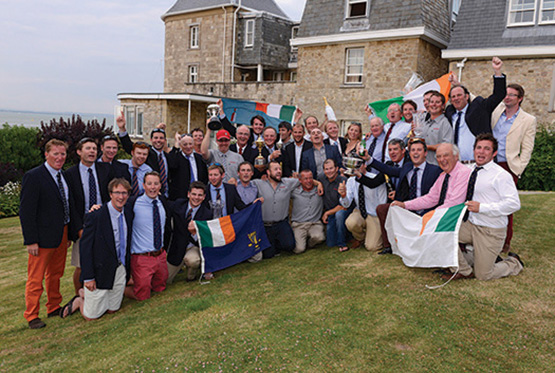
The big day – the Irish team park their tanks on the Royal Yacht Squadron lawn in Cowes after winning the Commodore’s Cup, July 2014
It all looked so easy once 2014’s win had been stitched up. But as the post-series review here on August 2nd 2014 revealed, the stresses and strains – particularly on Anthony O’Leary who did the heavy lifting in putting the team together and keeping the show on the road – were beyond most people’s imagining.
With hindsight now, it is easy to say that it was somewhere back towards Easter this year that the writing on the wall began to appear about how Ireland was going to have to opt out of the 2016 series. The new wave of Fast40+ boats on the Solent in the RORC Easter Challenge had been giving the already senior Antix a very hard time. If Anthony O’Leary and his crew were going to give of their best in campaigning their own boat in what is rapidly emerging as the hottest class in Europe, then they didn’t really need the distraction of rustling up a Commodore’s Cup team to add to their struggles.
For sure, back in 2014 the Commodore’s Cup was top billing. But the remorseless growth of the Fast 40s is making them the top show in town for 2016. They’d seven or eight of them in serious contention last year. At Easter, it was 10 and 11 boats, many of them barely out of the wrapping. In two weeks time, when they have their next major three day event on the Solent from May 20th to 22nd, we will be looking at a dozen and more boats so hot you could fry an egg on them.
Numbers like this, at this level of competition, inevitably attract the heavy hitters among owners and top professional sailors, providing a challenge which you either take head on, or opt out of altogether. For the amateur crew of Antix, it’s a case of take it or leave it. In taking it with full commitment to Fast40+ racing, they simply have to accept that they can’t overload themselves by the extra effort of running Commodore’s Cup involvement, though perhaps they could contemplate being in an Irish squad if by some miracle the perfect team package is put completely and exactly in place by some sort of offshore racing fairy godmother.
But you don’t get fairy godmothers in the rough tough world of offshore racing. The perfect dream package isn’t there, and it won’t be. So Antix and her crew of dedicated amateurs are going to be in the David and Goliath situation of throwing themselves totally into the fray of the Fast 40s, and we can only hope that the original David and Goliath scenario is replicated, for this is definitely the big boys’ game.
And yet, and yet……there’s no such thing as an inevitable outcome. Who knows what might emerge from the first proper gladiatorial confrontation of the Fast 40s in their newly confident expanded numbers? We may be saying this morning that an Irish defence is over and out. But surely it’s not beyond the realms of possibility that in the heady post-regatta atmosphere at the RORC’s Cowes base in a fortnight’s time, somebody might say: Why don’t we as a crew take a boat and join up with Antix and the new JPK 10.80 to race for Ireland?

The JPK 10.80 Courier du Leon wins the 2015 Rolex Fastnet Race
Stranger things have happened in putting Commodore’s Cup teams together in the past. In 2014, so speculative was the buildup that Anthony O’Leary admitted afterwards that until the American Ker 40 Catapult was actually unloaded from a Transatlantic ship on European soil, he wasn’t a hundred per cent convinced she was going to appear at all.
Yet ironically, there was Catapult on the quay as hoped for, after various dockside and clubhouse meetings and negotiations in Key West way back in January. But the whereabouts of the team’s third boat Quokka 8, which had been chartered by Michael Boyd and Niall Dowling, was now a matter for concern.
She’d been campaigning in the Caribbean through the winter, but had been scheduled to be shipped back in plenty of time for the start of the new RORC offshore season. But the ship she was aboard was re-routed, then re-routed again. She arrived back this side of the Atlantic barely in time for the team’s first get-together at Volvo Cork Week in July 2014. But then it all became sweetest fantasy, as Quokka won Volvo Cork Week overall, following which the Irish team won the Commodore’s Cup going away.

Quokka 8, overall winner of Volvo Cork Week 2014
So who knows what might just somehow develop. But meanwhile the critics are sharpening their knives, and there’s much muttering about it being disgraceful that Ireland doesn’t look like defending a trophy we were so pleased to win just two short years ago.
Thus a suggestion is floating around that ICRA should be prepared to allow just about any old team to go and join the scrap for the Commodore’s Cup 2016. Why not, they suggest, just allow three J/109s to go along to represent the Ould Sod, and give their crews a real taste of sailing at the sharp end?
Certainly the Commodore’s Cup as a Sail Training event has a distinct Quixotic appeal. But underneath the whole story is the reality that while in places like the Solent the top end of high-profile sailing is invariably dominated by professionals, within and around Ireland we don’t really do professional competitive sailing at all.
We’re compulsive and obsessive amateurs, and that’s the way we like it. If our sailing isn’t fitted in to cherished little slivers of free time carved out of the day job, then we don’t really think it’s genuine sport at all. Thus while it’s fine and dandy every so often to take on the Solent heavies and maybe just occasionally show them the way, we’d just as soon save our limited holiday time for a proper tilt at the West Cork Regattas or events like the ICRA Nationals, where we’re racing against people we know, and not shelling out money for exorbitant Cowes rentals. Like it or not, that’s the way we are.
Meanwhile, it’s rumoured that the 2018 Commodore’s Cup will be based of teams of just two boats each. Now they tell us…….But that’s not teams. That’s multiple doubles matches.
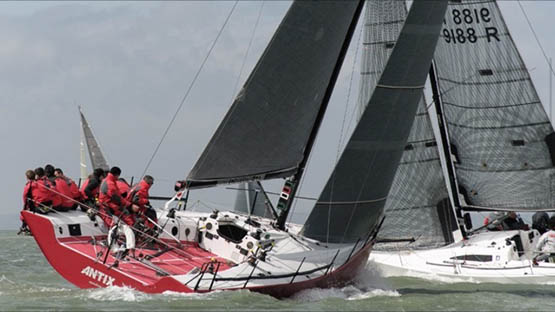
A demanding animal to sail. The tiller-steered Ker 40 Antix is not for the faint-hearted
Read also: ICRA Statement on 2016 Irish Commodore's Cup team
The Irish Cruiser-Racer Association (ICRA) is a unique organisation. “Run by sailors for sailors”, it is nevertheless a very land-centric administrative body whose only manifestation afloat as a group with its own identity is seen at the organisation of the annual ICRA Nationals. And the sense of it relating purely to the island of Ireland is accentuated by the fact that much of its work is essentially back-office activity, dealing with handicaps and all the other paraphernalia involved in providing the nation’s numerous and very diverse cruiser-racer fleet with meaningful racing. W M Nixon went to last Saturday’s ICRA Conference to get a flavour of what ICRA does, and came away both impressed and stimulated.
Sweeping along southwestward towards Limerick on our wonderful motorway system, while one’s body stays firmly on the dual carriageway, the mind can wander into any pathways it wishes. So we got to thinking that, in this age of increasing numbers of administrators trained to third level degrees in the running of not-for-profit organisations, it’s a bit odd to find a very successfully central organisation which is apparently run – and well run at that - on a Corinthian basis “by sailors for sailors”.
Surely in today’s climate, which favours key bodies such as this being run by highly-trained specialists on at least a semi-professional basis, a seemingly amorphous organisation which is “run by sailors for sailors” is verging on a clear case of the asylum being taken over by the lunatics?
We’d soon see. Meanwhile, why on earth hold an annual conference in Limerick? With Ireland’s population distribution changing so rapidly, skewing both towards the large urban centres and particularly towards the east coast and Dublin, surely anyone organising a national conference would find it attendee-friendly to look at the latest map of population weighting. As it happens, I’m not sure that such a map exists, but we’d like to think that with today’s computers it is possible to construct a map where, after due calculation, you could pinpoint to the exact centre of Ireland’s total population distribution.
So you set out heading for Limerick at an unfeasibly early hour thinking that maybe a central location such as pretty Portlaoise or tidy Trim would probably be Ireland’s central point in relation to population distribution. But after some smooth time on the road with the sense of the wonderful west coast coming ever nearer, you begin to wonder why ICRA didn’t make a proper job of it, and take us to Dingle where we can breathe that wonderful Atlantic air and think great thoughts of sailing the high seas.

Far from the pressures of the cities of the east and south coasts, Dis-a-Ray is moored in the peaceful surroundings of Tarbert, where the south shore of the Shannon Estuary has already become part of the Kingdom of Kerry. Photo: W M Nixon
As it is, though the Dubs may think of Limerick as being on the western seaboard, it’s actually remarkably central when you draw lines across Ireland between all the best sailing locations. And as we knew that the position of Commodore of ICRA was going to pass on Saturday from Nobby Reilly of Howth (the Dingle of the East Coast) to Simon McGibney, Limerick was just about spot on in terms of equal travel time. For although the new Commodore has Foynes YC on the Shannon Estuary as his home club, his Dehler 101 Dis-a-ray is actually moored at his home at Tarbert which is further west down the Estuary, so much so that Tarbert is in the Kingdom of Kerry.
We arrived in to find a virtually full house distributed around a room-circling table such as they use for international diplomatic conferences to make peace with rogue states, with the layout being planned so that everyone can be an equal participant. It was grand for those of us who had arrived in the nick of time to get a seat, as we’d the fully-equipped table in front of us (did anybody else find it the devil’s own job to open the rather good but tightly-wrapped little sucky sweets which are essential to a talking shop?), but being Ireland several people arrived late, the show was already on the road, and they’d to find a seat as best they could.
All of which meant that there was a bigger turnout than expected, which is good news for ICRA. And for those of us comfortably ensconced, it made for a fascinating throughput of information by a long list of speakers, even though the layout meant that networking was restricted to the one hour lunch break if - like many people - you were relying on the 3.30-3.45pm wrap-up to facilitate returning to Dublin or Cork or wherever for a completely different event that night.
From the beginning, the dominant theme was on how we get more people into sailing, and everyone blithely talked as though we’re offering Joe Public a warm and sunny Croatian sailing product right here in Ireland, cheerfully ignoring the fact the last two summers have been plain lousy in terms of good weather.
Certainly the sailing was great for the enthusiast, but can you imagine a newcomer to the rough and ready sailing world wondering where on earth the attraction of it all was to be found as they were blown and bashed around at what we thought of as the utterly wonderful ICRA Nationals at Kinsale in June, or took in the all-too-typical variety of Irish summer weather at the hugely successful Volvo Dun Laoghaire Regatta in Dublin Bay in July?
Yet there is a fresh demand out there, and two of the morning’s speakers, Alistair Rumball of the Irish National Sailing School in Dun Laoghaire and Des McWilliam of McWilliam Sailmakers in Crosshaven, gave excellent talks on encouraging it, with Alistair showing us how his programme of moving beginners through dinghies and on into the school/club’s1720s, then became an inevitable progression into gaining experience and instruction on the school’s Prima 38 Lynx.
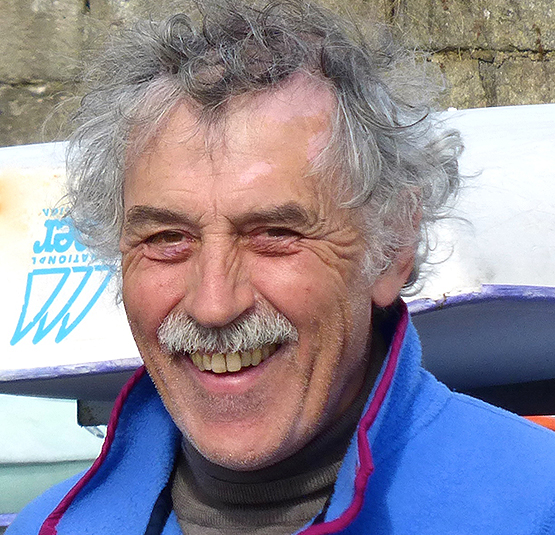 The mover and shaker. Alistair Rumball’s Irish National Sailing School in Dun Laoghaire is first port of call for many newcomers to sailing. Photo: W M Nixon
The mover and shaker. Alistair Rumball’s Irish National Sailing School in Dun Laoghaire is first port of call for many newcomers to sailing. Photo: W M Nixon
“Lynx has been a greater success than we could have ever dreamed of” he said. “She has been so booked out with people keen to learn about sailing a cruiser-racer that we haven’t been able to get as much actual racing with ISORA and so forth as we’d like. But for 2016, she’s being taken out of our Dun Laoghaire setup for long enough to be organised for a proper shot at the Volvo Round Ireland”.
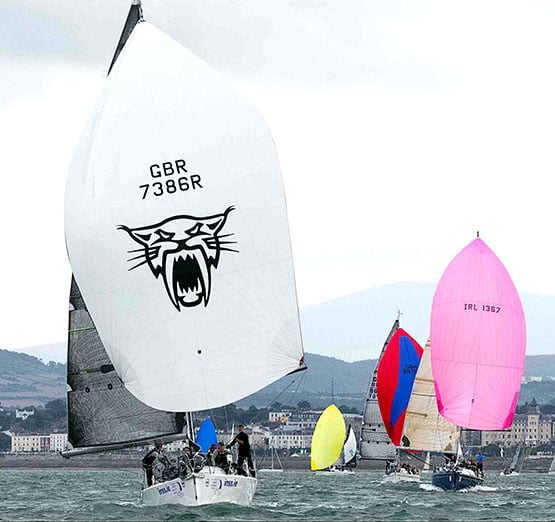
The double life of a Prima 38. The INSS’s Lynx in full racing mode in Dublin Bay (above), while below she is seen in early training mode as she takes a crew of beginners in cruiser-racing out for some formative experiences

As of last weekend in Limerick, there were just two crew places left aboard Lynx for this year’s Volvo Round Ireland on June 18th, and they’ve probably been snapped up by now. But the Rumball presentation underlined the fact that there are people out there who are mad keen to get into cruiser-racing, and it was up to ICRA to guide its members as to how best to tap into these wannabee sailors, instead of bleating all the time about how hard it is to find crew.
Des McWilliam leapt into the same theme, and gave us a crash course in how to make crewing on your boat more attractive to strangers. Admittedly the experience of seven years of acute economic recession have understandably made those who have kept boats in racing commission more than a little stressed. But if they want to reap the benefits of having struggled to stay in the boat-owning stream, then they have to make their cruiser-racers pleasanter to sail on, and more effective racing machines.
The McWilliam message was blunt in the extreme. “As a sailmaker in Ireland, each year I will race actively at many venues on upwards of 40 boats, both evenings and weekends. I will experience many different management and sailing styles. At the end of the year looking back, I usually realise that there might be only ten to a dozen boats out of that total of forty to which I would gladly and freely return for the good sport, the efficient sailing, the successful racing, the camaraderie – the fun. The rest of them are just work, involving duty visits. Please remember this when you are setting up the running of your boat, and trying to encourage people to sail with you.”
Des McWilliam of Crosshaven and Rory Staunton of Mayo. Des provided the meeting with some telling home truths about how attractive (or not) cruiser-racers throughout Ireland can be to sail on, while Rory Staunton led the charge in wondering why ORC and IRC cannot be amalgamated, and then went on to outline a new trailerable 33-footer he and an international group of friends are developing to make the incomparable west of Ireland a more accessible sailing area
We earned our lunch by going through an intensive session with Dobbs Davis of the Offshore Racing Congress, who had come to the conference with Zoran Grubisa to promote their measurement rule, which is used worldwide anywhere that IRC is not dominant, and in some key events such as the Rolex Sydney-Hobart Race, they are used in tandem, though IRC is currently the more-used system in that classic event.
It says everything about how Irish sailing punches way above its weight that these two guys thought it worth their while to come among us and evangelise for their system in a country which has a more-than-friendly relationship with the IRC and the people who run it. But it was fascinating stuff, making an input which added real spice to the day.
Davis is Chairman of the ORC’s Promotion & Development Committee, while Grubisa heads the Rating Officers Committee, and they run a system which is now the ISAF-approved rating method for the ISAF Offshore Worlds, which this year will be staged in Copenhagen in July, which as it happens is more or less the same time as the Royal Cork YC will be staging the new European IRC Championship in Volvo Cork Week at Crosshaven.
So the presence of the evangelists from the ORC at the ICRA conference could have opened up a right can of worms, but fair play to Dobbs Davis, he gave such an enthusiastic and lucid explanation of the completely transparent way in which ORC function that, for the time being at least, one’s instinctive loyalty to IRC was suspended out of intellectual curiosity.
Leading Offshore Racing Congress officers Zoran Grubisa (left) and Dobbs Davis were in Limerick to evangelise for the ORC Rating system
While IRC still has one or two hidden elements – the “Black Box” factor – with the transparency of ORC, you can always see how different inputs are effecting the final figure. One-design sailors may find all this utterly yawn-making, but as Davis pointed out, although there are so many successful cruiser-racer One-Design classes in America that ORC has yet to gain significant traction there despite being first set up in the US forty years ago, elsewhere in the world more and more people are coming to ORC as they enjoy watching boat innovation and performance analysis interacting to make their sailing more interesting and the results indicative of pure sailing ability.
The approachability of the ORC system was presented as one of its advantages
The slice of the cake worldwide for the different rating systems
But as we all know, where IRC and OCR are run side-by-side, despite the IRC’s hidden elements the two outcomes are often very similar. And in Ireland where we have a soft spot for the old S&3 34s which set world alight in 1969-73, the fact that the veteran though beautifully restored S&S 34 Quikpoint Azzura was overall winner of the Rolex-Sydney Hobart Race under OCR, after so nearly doing it on IRC, caused a bit of heart-searching. But nevertheless Rory Staunton from Mayo SC spoke for many when he demanded to know why IRC and ORC couldn’t get together and resolve their small differences for the general benefit of the offshore racing fraternity. Dobbs Davis said his door was always open, but that began to feel a bit too reminiscent of the current efforts to form a government, so we were glad enough to take a break for lunch and then return to the rating topic, but from an entirely different point of view
The inevitable expense in maximizing your boat’s performance potential under either IRC or ORC made the sheer economy of ICRA’s Progressive ECHO system seem immediately attractive, and the lead-in the afternoon session by SCORA Commodore Ronan Enright even more apposite. Because the fact is, you could run the Progressive ECHO Handicap System without even knowing what a boat looks like, let alone having her dimensions measured do the last millimtre.
Donal O’Sullivan of Dublin Bay SC, and Ronan Enright, Commodore SCORA, discussing sailing administration matters during the lunch break at Limerick. Enright went on to give an illuminating presentation about developments in Progressive ECHO Photo: W M Nixon
In the absence of ICRA’s ECHO supremo Denis Kiely - unavoidably absent for family reasons – Ronan Enright gave a quietly telling performance. It’s fascinating that though ECHO started life as the East Coast Handicap Organisation back around 1971-72, it’s now a nationwide service overseen by ICRA, and its most active area of development is in the cauldron of concentrated cruiser-racing which you find when the activities of Cork Habour and Kinsale are combined.
Basically, Progressive ECHO depends on the results of the most recent race, after which, if certain criteria have been fulfilled, the results are automatically re-computed to give boats a new rating based the supposition that they had all finished dead level on handicapped time. My own most recent experience of racing with it when it is being enthusiastically applied was in the Volvo Dun Laoghaire Regatta, which was a perfect test-bed for the system, as it was a compact series with the same fleet throughout.
The result is a series-long level of commitment by boats and crews who, under a more brutal system, would have seen their interest and enthusiasm flag after Day Two or even earlier. So really the message is: If we’re trying to get people to enjoy sailing and particularly to enjoy racing which is what the non-involved most easily comprehend, then Progressive ECHO is doing more to get bums on boats than anything else in Irish sailing, for believe me you have never seen anything quite so heart-warming as the response of a crew who, under One-Design or fixed handicap systems, had not been at the races at all, yet suddenly under Progressive ECHO they find they’ve recorded a win.
Which was all good news but perhaps the most interesting revelation of all from Ronan Enright was that the top IRC racers around Cork are now taking a closer interest in their Progressive ECHO showing than there are in their IRC results. For under IRC, they know they’ll be in the top six, but each post-race adjustment of Progressive ECHO gives them a very clear message about just how well or not they were really doing on the day.
Tom MacSweeney of this parish then hosted a forum which basically came down to how sailing can present a more friendly and accessible response to people who might be vaguely interested, and could be potential sailing enthusiasts. This involved him drawing on his training as a critical journalist, for as he admitted, when he first turned up with his first sailing boat – a Ruffian 23 – in Crosshaven, everyone from Denis Doyle downwards immediately made him welcome. But we can all think of non-assertive characters who are great sailors, yet if they hadn’t been in sailing families in the first place, they might not have taken up the sport at all owing to the sometime apparently closed nature of “yachting”.
We learned that very little of an Achill yawl is showing above the water after she capsizes. This is how they look in proper order
Allied to Des McWilliam’s incisive look at boats which you like to be aboard, and boats which you definitely don’t, and it all provided food for thought, as too did John Leech of Irish Water Safety with his no-nonsense presentation about a mature approach both to safety, and to being rescued. In an interesting mix of images, he showed us a photo of what happens to an Achill yawl when it capsizes. The result is an awful lot of rather waterlogged traditional boat under the surface, and only a little bit showing with the crew perched on top. As Des McWilliam was probably the only other person present with any idea of what an Schill yawl in full health looks like, the least we can do here is show you a photo of them in good sailing order. Meanwhile, John Leech concluded by saying that when you call out the ASR helicopters, think rather of how you can prevent your mast – if it’s still standing – from interfering with the rescue. Don’t for heaven’s sake use up emotional energy thinking about how much it all costs. They’re on standby all the time, and you the taxpayer have paid for them in the first place.
We concluded with Rory Staunton seeking interest and opinions for the new 33ft trailerable One-Design. While we all hope to get down to Clew Bay to sail the prototype this summer, could I suggest that one of the most exciting projects on the Irish cruiser-racer horizon is WIORA Week 2017 in the Aran Islands. So when they’ve finally got around to fixing a date, maybe the promoters of the new 33-footers could arrange to have a flotilla of them in Kilronan in 2017 to give the class a rocket-assisted launching.
Meanwhile this year’s WIORA West Coast Championship is under the auspices of the Royal Western of Ireland Yacht Club at Kilrush from June 29th to July 2nd. There’s so much extraordinary history in being able to write that simple bit of information that I reckon we’ll have to give it a complete blog in the future.
As for the ICRA Nationals, they’re at Howth from June 10th to 12th with both IRC and Progressive ECHO being used, while Volvo Cork Week comes up in July after the Volvo Round Ireland race has been tidied away in late June.
Although last Saturday’s Limerick gathering was essentially a wide-ranging conference, it was also the changeover to the new Commodore, with Simon McGibney taking on the mantle from the energetic and enthusiastic Nobby Reilly whose own boat, the Mills 36 Crazy Horse, was seen in virtually every event, and looked like heading for the win in Class at the ICRA Nats in Kinsale last June until new big winds swept George Sisk’s WOW to the fore. During Nobby’s busy time in the top office, ICRA’s activities and its reach steadily expand, while thanks to the persuasive efforts of Anthony O’Leary, a Commodore’s Cup team was assembled which regained the trophy in 2014.
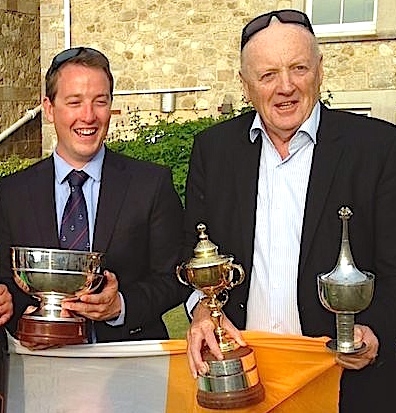 Ross MacDonald and ICRA Commodore Nobby Reilly at the Royal Yacht Squadron in Cowes in July 2014 after Ireland had won the Commodore’s Cup. At the ICRA Conference in Limerick last weekend, McDonald won a special award for his season’s results in 2015 with his X332 Equinox, while Nobby Reilly stood down after his successful years as Commodore, handing over the helm to Simon McGibney.
Ross MacDonald and ICRA Commodore Nobby Reilly at the Royal Yacht Squadron in Cowes in July 2014 after Ireland had won the Commodore’s Cup. At the ICRA Conference in Limerick last weekend, McDonald won a special award for his season’s results in 2015 with his X332 Equinox, while Nobby Reilly stood down after his successful years as Commodore, handing over the helm to Simon McGibney.
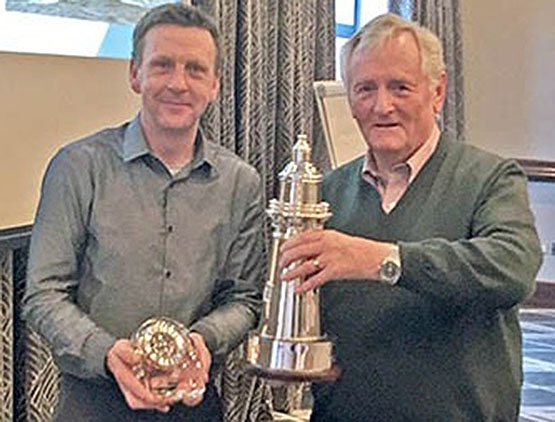
New ICRA Commodore Simom McGibney presents the “Boat of the Year” trophy to George Sisk of the Royal Irish Yacht Club, skipper of the Farr 42 WOW.
Work is going on behind the scenes to provide a strong defence this summer, but Anthony O’Leary wasn’t in Limerick to tell us about it, as he was away on his annual participation in America in the Viper 640 Championship, which just wouldn’t be the same if O’Leary wasn’t taking part - so much so that last year, he wasn’t present when his name came up as “Sailor of the Year” in Dublin, for he was away then too, Viper racing in the sun.
But other top sailors were there to round out the conference with the annual awards such as special performances by the likes of Dave Cullen with Checkmate XV and Ross Macdonald with Equinox and, while the ICRA Boat of the Year presentation, with warm acclamation, went to George Sisk of WOW, who not only admitted that his well-tested craft usually races with a crew of average age 53, but if he himself didn’t happen to be on board, the average age came down considerably………..And in case you think becoming ICRA Boat of the Year is all about glamour racing in sunshine, we close with a photo of WOW and the JPK 950 Alchimiste crawling towards the starting line for the Dun Laoghaire to Dingke race on the sort of damply windless evening that most folk would much prefer to spend comfortably at home.
It isn’t always glamour and warm sunshine and pleasant breezes. 2015 ICRA Boat of the Year WOW on a damp and windless evening approaching the start of the 280-mile Dun Laoghaire to Dingle race with the JPK 960 Alchimiste.
New ICRA Commodore Takes Office Next March As Cruiser–Racer Conference Gets New Date
The inauguration of the Irish Cruiser Racing Association's (ICRA) first ever 'West of Ireland' commodore will take place in Limerick next March, a month before the start of the 2016 summer sailing season.
The move away from the traditional November ICRA Conference date is to produce a more relevant 'pre–season agenda', an ICRA spokesman says. The one day event is also being designed to provide members with up–to–the minute information on a bumper Dublin–based 2016 national championships in June (10-11th).
Delegates will elect WIORA stalwart Simon McGibney, from Kilrush in County Clare, as commodore and also hear from outgoing commodore Nobby Reilly of Howth YC. Reilly's last role in office will be to present ICRA's coveted 2015 'Boat of the Year Award' as well as welcoming the national championships back to his home club.
The forum will include round table discussions on the future direction of the Irish sailing scene.
The annual pow–wow, provisionally earmarked for March 5, (venue to be confirmed) is open to all sailors and will include a number of key presentations including a Commodore's Cup briefing on plans for Ireland's Cup defence in Cowes plus the impact of the new Cup format on the three boat team configuration.
There will also be details on June's Round Ireland Race from Wicklow as well as July's Cork Week Regatta at Crosshaven.
The conference line up also includes a focus on handicapping and an insight into the local ECHO system and, say ICRA, just how powerful the system is when used properly.
Any further items for the ICRA conference agenda are welcome.
#sovscup – It's only now, with clear signs that the Irish economy is on track to return to vigorous health so long as everyone is reasonably sensible, that we can look for a real upturn in sailing enthusiasm. But with a good fleet getting great racing in the four day ICRA Nats/Sovereigns Cup in Kinsale, there's no denying a growing atmosphere of optimism. WM Nixon muses on the new mood, sets Kinsale in the local and national context, and speculates on the cast of thousands who might be on the podium when the championship finishes this evening.
When Ireland was still reeling from the savage economic downturn which followed the Celtic Tiger years, active numbers in sailing showed a marked decline. The nadir was reached in 2012, when the Irish Cruiser Racer Association failed to raise a three boat team to defend the Commodore's Cup which had been won so stylishly by Anthony O'Leary and his squad in 2010.
That it should have come to this.......After all, at the height of the boom years, there'd been three Irish Commodore's Cup teams competing for the same trophy. So the 2012 No Show served to emphasize the severity of the decline. But ICRA gritted its teeth, and planned accordingly. While Anthony O'Leary quietly beavered away under the radar on what was virtually a solo run in putting together a Commodore's Cup team which was to make a triumphant return to the fray in 2014, the national offshore racing authority had meanwhile been calculating the odds on getting good turnouts in its annual Irish championship.
There were hopes that there would continue to be a respectable turnout when the ICRA Nats were staged in Dublin Bay, as they'd be with the Royal Irish YC in Dublin Bay in 2014. And those hopes were duly fulfilled, even if many boats were racing with older sails than would have been the case in the boom years, while new boats were as rare as hen's teeth.
But for the first of the unforeseeable years beyond 2014, it was reckoned new thinking was required, and ICRA's number cruncher Denis Kiely came up with the notion that for 2015, it would make sense to run the ICRA Nats in conjunction with the established biennial Sovereigns Cup Regatta in Kinsale. To most, it seemed a good idea. A superb venue. And a very experienced race management team with a fine track record in the Sovereigns and other major events. All they needed to demonstrate their capabilities was a decent fleet. But with active cruiser-racer numbers weakened on the south coast, a decent turnout could not be taken for granted without some magic Ingredient X to encourage boats to travel from other areas.
Like it or not, the two words "National Championship" are Ingredient X. And in ICRA's case, there's multiple value, as their National Championship provides racing for a total of nine classes, and seven of those classes are racing under both IRC and ECHO.
It takes a while to get your head round all this, but it means that tonight there could be a total of sixteen different crews who can rightfully claim to be National Champions. Add in further multiple permutations which might just emerge among the minor places, and it's within the remoter realms of possibility that about half of the 109 boats taking part will be able to claim, when they've finally wended their way home along most of the coasts of Ireland and beyond, to have had a podium place in a National Championship.
So what's not to like? For a sailing community emerging from an economic recession so disastrous we still haven't really grasped its extent and depth, an event which aims to provide something for half the people in the audience is just the ticket. And if harsh critics say that this is fantasy sailing, the photos – particularly from yesterday's sun-blessed racing – tell us otherwise.
And as for the venue, well, there's something unreal about Kinsale anyway. It seems too good to be true. Yet it is there, and it's for real. And all the factors which saw it relinquish its position as the south coast's premier Naval Port from around 1750 onwards work together to make it the perfect sailing venue for our own times.

Toytown harbour – Kinsale's compact size made it obsolete as a naval port as ship sizes grew from 1750 onwards, but the same factors make it perfect as a sailing venue today.
For Kinsale is a sort of Toytown. When it was at its height of naval importance, ships were much smaller, and harbour towns had to be as compact as possible to provide them with defence. But as ship sizes grew rapidly, Cork Harbour began to take over, and on Cork Harbour, it was Cobh with its big, new and confident sea-facing terraces of houses which became the expression of a growing naval presence.
By contrast, Kinsale in its great naval period around two or three centuries ago had generally smaller houses which clustered along both sides of a winding and very narrow main street which ran along the shoreline, but didn't provide a waterfront as we know it now. And though the Royal Navy had shifted its emphasis to Cork Harbour, Kinsale continued to house an army garrison to keep the place busy. That's why Kinsale is such a fascinating place to visit by boat. What you see is not what you're going to get. The "new" waterfront may be gradually developing, but the real Kinsale with its myriad of good restaurants and pubs is to be found in a rabbit warren of little streets which hark back to a much earlier age.

Kinsale's rabbit warren of little old streets dates back a long time
 The contemporary waterfront of Kinsale is on reclaimed land along the original uneven and marshy shore. The houses on the south side of the main street had their backs to the sea, and Kinsale YC (on the extreme left) is a mixture of old and new, with the modern south-facing part of the building, looking towards KYC marina, added to the back of a handsome town house which faces north away from the harbour.
The contemporary waterfront of Kinsale is on reclaimed land along the original uneven and marshy shore. The houses on the south side of the main street had their backs to the sea, and Kinsale YC (on the extreme left) is a mixture of old and new, with the modern south-facing part of the building, looking towards KYC marina, added to the back of a handsome town house which faces north away from the harbour.
 Once upon a time, this was the most important trading and naval port on the south coast, but Kinsale today is all about sailing and fishing.
Once upon a time, this was the most important trading and naval port on the south coast, but Kinsale today is all about sailing and fishing.
It has an attractively prosperous and busy air to it all, but it's not so long ago that Kinsale seemed a place in irreversible decay. Time was, though, when it had enough people in business in the 1800s to support busy local sailing, and the Royal Cork YC's most famous trophy, the Kinsale Kettle of 1859, attests to this, while a regatta was reported as early as 1839. The Thuillier family set much of the waterborne pace, and John Thuillier's fascinating book Kinsale Harbour – A History (Collins Press, 2014) puts a complex story into perspective.
Ship and boat building was part of the scene, but sometimes the shipwright branch of the Thuilliers built a yacht, the most famous being the 35ft cutter Tertia from 1898. According to Lloyd's Register, she was designed by a local clergyman, the Reverend Welsted, but the folk in Kinsale reckon the Thuillier brothers put manners on the Reverend's vague drawings to make Tertia a real performer.
Certainly around Kinsale she's remembered as a boat which – during the 1920s and '30s – used to give Harry Donegan's famous Gull a hard time on the competitive course, particularly in the legendary August weekend "ocean race" from Cork Harbour to Kinsale. But inter-harbour rivalry is such that around Cork Harbour – where she was ultimately based, ending her days as a fishing boat in Cobh - she's remembered as the boat in which a very young crew, under the command of the then 15-year-old Clayton Love Jnr, sailed from Cork Harbour to Dublin Bay early in the summer of 1944. Ireland was so cut off from much of the rest of the planet during World War II that it was only when the young sailors arrived into Dun Laoghaire that they found they'd been making their voyage during D-Day, but that's a story for another day.

Tertia, designed and built in Kinsale in 1898. In June 1944, she was cruised from Cork Harbour to Dublin Bay, but her crew of schoolboys only found out after they'd arrived in Dun Laoghaire that D-Day had happened while they were at sea.
By the late 1940s, Kinsale was only a shadow of its former sailing self, but some such as John Henry Thuillier and Dick Hegarty continued to keep the faith, and by the 1950s Kinsale Sailing Cub – nowadays Kinsale Yacht Club – was in being, the pace gradually increasing until it today it is one of Ireland's top ten, and was the Mitsubishi Motors "Club of the Year" in 1998 and 2014.
With its glorious yet compact natural harbour leading into the midst of the hospitable and historic town, Kinsale is Ireland's most popular international cruising destination. But as has been seen these past three days, it lends itself equally well to being a racing venue, and with the weather picking up as the current four day regatta has progressed, we face into the final day with top sport guaranteed.
As for the number of visiting boats, they have been the making of the event. The Royal Irish YC – hosts for the 2014 ICRAs – have sent seventeen spread across most classes, while Howth – who step up to the plate to host the 2016 ICRA Nats – have sent fifteen, with their Kinsale HQ established in The White Lady.

Team spirit. The successful squad from Howth YC have established their Command HQ in Kinsale in The White Lady. Photo: Kevin Burke

The veteran X332 Equinox (Ross McDonald). As the wind has freshened, Equinox has consolidated her lead in Div 2, even though the three Half Tonners had shown ahead in the early races.

The successful modified Half Tonner Harmony (Jonny Swan and Jim Freyne) clearly subscribes to the theory that best speed downwind in light airs is best obtained through keeping weight well away from the stern.
It seems the Howth men and women are in serious training for 2016 already, as they're in there battling at the top of several classes, and even with today's races still to be sailed, your money would be very safe betting on a Howth boat to win Division 2, as they're in the top four places after six races.
The series started in a gentle and muggy southerly breeze, and in the soft going the light breeze specialists did mighty well, with the three hot Howth Half Tonners – Dave Cullen's Checkmate XV, Jonny Swan & Jim Freyne's Harmony, and the Evans brothers' Big Picture – vying for the lead.
But as the breeze sharpened over the next couple of days towards yesterday's sunny power-blast which saw sails torn, spars broken, and four crewmen over the side, Ross McDonald's veteran X332 Equinox found conditions increasingly to her liking, and last night as the discard swung into place, she moved clear on top with a discarded fourth while counting four bullets and a third.
ICRA Commodore Nobby Reilly – also from Howth – has likewise been having a good series up in Class 0 with the Mills 36 Crazy Horse, which he co-owns with Alan Chambers. Crazy Horse's performance hasn't been at all impaired by having the great Dave Harte of Schull on board, though the notching of discards had been to the advantage of Andy Williams from south Devon with the Ker 40 Keronimo (Class 0 find great inspiration in the names of Native American chieftains) which was only two points adrift on the Horse.

The Mills 36 Crazy Horse (Nobby Reilly & Alan Chambers) has the points lead in Division 0 going into the final day's racing in the ICRA Nats this morning.

The Ker 40 Keronimo (Andy Williams, Yealm YC) was a contender for the top slot in Dvision 0, but damage in yesterday's second race has resulted in her withdrawal from today's races. Photo: Courtesy KYC.
However, in the breezy second race yesterday, Keronimo had such a contretemps with her spinnaker that it resulted in serious damage to her pulpit and liferails which cannot be repaired in time for this morning's first race, and she has withdrawn. This means that second overall in Div 0 is now likely to be George Sisk's Farr 42 WOW (RIYC), which is thus doing best in class of the three gallant Dun Laoghaire boats which did the recent Dun Laoghaire to Dingle Race before coming back to Kinsale. The other two are the J/109 Dear Prudence (Bourke, Cummins & Lyons, RIYC) currently 16th in Division 1, which has her astern of the twin-ruddered JPK 9.60 Alchimiste (Mike Murphy, NYC) – Alchimiste is 12th, which is some small compensation for being pipped by Dear Prudence by 50 seconds for fourth place in the race to Dingle.
Division 1 is a seriously strong brew, with Olympian Mark Mansfield of Cork helming John Maybury's J/109 Joker from the Royal Irish in what was developing as a battle with the new British J/109 champion, Ian Nagle's Jelly Baby from Royal Cork. But after yesterday's brisk sport, Scottish Series 2015 overall winner Rob McConnell from Dunmore East has got in between the two of them after scoring a first and fourth with his A35 Fool's Gold.
Division 2 we've looked at already, Division 3 sees another Howth boat on top, but this time it's only equal top for Richard Colwell and Ronan Cobbe's Corby 25 Fusion to lead on count-back, as they're level-pegging on 13 points with Tim Goodbody (RIYC) in the Sigma 33 White Magic. Captain Tim is relishing every minute of sport in Kinsale, as he has indicated that as Chairman of the Volvo Dun Laoghaire Regatta 2015 in ten days' time, he won't have time to campaign his own boat on Dublin Bay. White Magic got a first in the second race on Thursday, and with a second and a fourth yesterday, she's very much in contention.
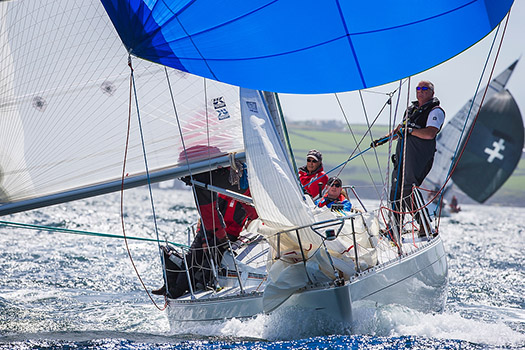
Tim Goodbody blasting downwind in his Sigma 33 White Mischief in yesterday afternoon's race. He currently lies equal first in Division 3 at Kinsale, and it's his last opportunity for some sport afloat before his duties as Chairman of the Volvo Dun Laoghaire Regatta take over completely in ten days time. Photo courtesy KYC
The Quarter Tonners and others in Division 4 are well led by Tony Hayward's Blackfun from Cowes, which – thanks to consistency – is all of ten points ahead of a couple of J/24s, Kilcullen with the Under 25 squad from Howth, and Flor O'Driscoll (who doesn't quite qualify for an Under-25 squad) with Hard on Port from Royal St George YC.
In the two White Sails Divisions which have their starts in civilised style in the harbour off Charles Fort, we just can't sidestep the fact that Howth boats are setting the pace again, with Colm Bermingham's Elan 333 Bite the Bullet three points clear of Paul Tully (DMYC) in his sister-ship White Lotus in Non-Spin Div 1, while Non Spin Div 2 sees HYC's Windsor Laudan and Steph Ennis with the Club Shamrock Demelza (winners in 2014) ahead again in 2015 after logging four wins in the first four races.
Having sailed with this formidable duo in the ICRA Nats 2014, this is no surprise – they're a marvellous testimony to the racing potential of a good old boat well tuned, well cared for, and well sailed. But with plenty of wind expected from the south by this afternoon to round out the ICRA Sovereigns 2015, the Demelza team - together with all the other front runners in all divisions under whatever handicap systems – are going to have to play it cool to bring this great regatta to a safe and successful conclusion before the weather goes down the tubes again tonight.

Heading out from the start in Kinsale for yet another win. Demelza is probably the most successful of the veteran Club Shamrocks designed by Ron Holland in the 1970s. Currently owned by Windsor Laudan and Steph Ennis, Demelza won Div 2 (Non-spinnaker) in the ICRA Nats 2014 in Dublin Bay, and looks likely to complete a successful defence today at Kinsale. Photo: Peadar Murphy
Results – ICRA Nationals & Sovereign's Cup 2015
Day 3, after 6 races sailed (26th June 2015)
Division 0 IRC
1 Crazy Horse, Norbert Reilly/Alan Chambers (Howth Yacht Club)
2 Keronimo, Andy Williams (Yealm Yacht Club)
3 WOW George Sisk
Division 0 ECHO
1 Godot, John Godkin (Kinsale YC)
2 Forty Licks, Jay Colville, East Down YC
3 Roxstar, Jonathan Anderson, (CCC)
Division 1 IRC
1 Joker 2, John Maybury, (Royal Irish Yacht Club
2 Fool's Gold, Robert McConnell (Wicklow Harbour SC)
3 Jelly Baby, Ian Nagle, (Royal Cork Yacht Club)
Division 1 ECHO
1 Adrenalin, Joe McDonald (National Yacht Club)
2 Indecision, Declan Hayes (RIYC)
3 Gringo, Tony Fox (NYC)
Division 2 IRC
1 Equinox, Ross McDonald, (HYC)
2 Harmony, Jonny Swan/JamesFreyne, (HYC)
3 Checkmate XV, Davie Cullen (HYC
Division 2 ECHO
1 Harmony, Jonny Swan/JamesFreyne, (HYC)
2 Dexterity, Foynes Team (Foynes YC)
3 Black Velvet, Leslie Parnell (RIYC)
Division 3 IRC
1 Fusion, Richard Cowell, (HYC)
2 White Mischief, Timothy Goodbody, (RIYC)
3 Bad Company, Desmond, Ivers, Deasy (RCYC)
Division 3 ECHO
1 Powder Monkey, Liam Lynch, (Tralee Bay SC)
2 Maximus, Paddy Kyne (HYC)
3 White Mischief, Timothy Goodbody, (RIYC)
Division 4 IRC
1 Blackfun, Tony Hayward (Cowes)
2 Kilcullen, (HYC)
3 Hard on Port, Flor O'Driscoll (RSt.GYC)
Division 4 ECHO
1 Seven Whistler, Rene Wubben (WHSC)
2 Kilcullen (HYC)
3 No-Gnomes, Leonard Donnery, (RCYC)
J109
1 Joker 2, John Maybury (RIYC)
2 Jelly Baby, Ian Nagle (RCYC)
3 Storm, Pat Kelly (Rush SC/HYC)
Quarter Tonner
1 Blackfun, Tony Hayward (Cowes)
2 Anchor Challenge, Paul Gibbons (RCYC)
3 Quest, Barry Cunnigham (RIYC)
White Sail Division 1 IRC
1 Bite the Bullet, Colm Bermingham, (HYC)
2 White Lotus, Paul Tully, (Dun Laoghaire Motor YC)
3 Baccarat, Brian & Anthony McCarthy (KYC)
White Sail Divison 1 ECHO
1 Baccarat, Anthony/Brian McCarthy (KYC)
2 White Tiger, Tony O'Brien (KYC)
3 Cimarron IV (KYC)
White Sail Division 2 IRC
1 Demelza, Windsor Laudan, (HYC)
2 Loch Greine, Tom O'Mahony (RCYC)
3 Saoirse, Richard Hanley (KYC)
White Sail Division 2 ECHO
1 Privateer, Dermot Lanigan (KYC)
2 Valfreya, David Riome (KYC)
3 Demelza, Windsor Laudan, (HYC)
ICRA Link–Up With Kinsale 2015 Underlines Cruiser–Racer Willingness To Guide & Go With The Flow
#cruiserracing – As we start to emerge from seven years of recession, we find the world of sailing has undergone changes which may have not been noticed in the struggle for economic survival. To prosper today, it seems that sailing must hope to be family friendly, and accessible to spectators and would-be participants alike. W M Nixon reflects on how this is working out in the macho world of cruiser racing.
The ICRA Nationals 2015 will be combined with next year's biennial Sovereigns Cup in Kinsale in order to make the event more user-friendly, and comfortably exceed the required critical mass in terms of numbers participating. It is an utterly logical development. And it's scarcely sensational breaking news, as the dogs in the street have been aware of it for a while now, even if an official announcement has yet been made.
But for those who were rather taken by the original notion of the Irish Cruiser-Racing Association staging an annual stand-alone national championship event, rotated around maybe as many as half a dozen centres, this may seem like a retrograde step from the high-flown idealism of the founders. And their vision certainly worked when the streets were awash with money, and people continued to subscribe to the notion that it was acceptable for offshore racing types to devote virtually all their free time to their rather expensive sport, regardless of how anti-social it seemed to family and friends (if they had any of either).
Now, however, the money's gone, and if anything its absence has accelerated the move towards shared recreation. Whatever rugged traditional amateur offshore racing may have been in its heyday, it scarcely qualified as shared recreation. Its austere joys were confined to the direct participants, while the outcome of each contest was an arcane matter to be teased out and analysed only by a very small number of aficionados.
Yet the boats it developed proved popular, with one of the by-products being the acceptance and development of cruisers which sailed well and could, if wished, be realistically raced. In fact, in Ireland in particular, many of these boats with lids are never cruised at all, and no-one ever even overnights aboard them. So after you've had yet another samey day sail round the same familiar old bay, the idea of a spot of racing has appeal.
A boat regularly raced with a modicum of enthusiasm and skill will attract regular crewmembers who want to be sure of getting their fix of sailing once or twice a week, but who also have other things to do – they've other sports, hobbies and interests to take up the rest of their time in addition to the increasing demands of family and social expectations.
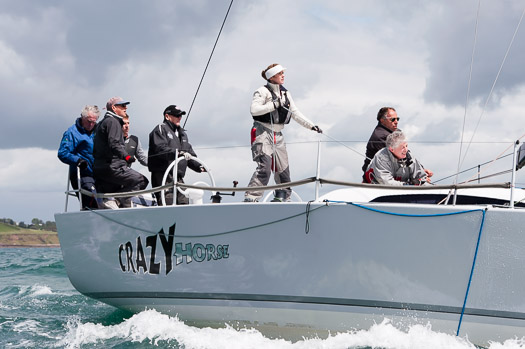
Steady steering afloat, and flexible management ashore....Nobby Reilly of Howth, Commodore of ICRA, helming his Mills 36 Crazy Horse. Photo: Bob Bateman
Lord knows it's all a very long way from the hundred per cent totally rugged offshore racing dedication of international legends like John Illingworth, Dick Nye, Carleton Mitchell and Adlard Coles, but this is the way we sail today. As for really serious stuff, we now leave that to highly-sponsored professionals in sailing machines. And as to any temptation to take part in challenging events, we focus on major happenings like the Fastnet and the Round Ireland. But the rest of the time, we seem to prefer a semi-inshore programme, and home in time for tea.
The ICRA management are a savvy bunch, and they are keen to provide what the market demands. In fact one of their number is Richard Colwell of RedC Polls, the noted opinion poll and market research outfit. His company is a bit busy at the moment – something about European and Local Elections next week – but once that's tidied away, he's going to run an exercise on what cruiser-racer folk really want in their annual programme.
It's not nearly as easy as it seems. If your organisation is going to benefit from successfully going with the flow, then you have to be able to outline a reasonably creative questionnaire structure to indicate where the flow might most usefully go in the first place. Chickens and eggs and all that sort of thing maybe, but good management has to manifest itself in many wonderful ways in a mixture of guidance and productive acceptance of the results of research.
However, before we look at how next month's ICRA Nationals in Dun Laoghaire are shaping up, the Kinsale link-up decision should be considered in the light of its effects on events beyond 2015. ICRA brings any co-operating club an unrivalled database and a hugely experienced race management and administration team. Thus, a neat linkup with an established regatta will confer enormous mutual advantages.
Yet surely it is essential for the good of Irish sailing overall - and particularly for the good of sailing at significant centres which are not holders of major biennial regattas – that from time to time the ICRA Nats continue to be staged as a stand-alone event?
Once the linkup has been made to the Sovereigns Cup at Kinsale, you can see the slippery slope with linkups to the Volvo Dun Laoghaire Regatta in Dun Laoghaire, and Cork Week itself. Carried to its logical conclusion, going with the flow to this extent would exclude other regatta-less centres on a permanent basis.
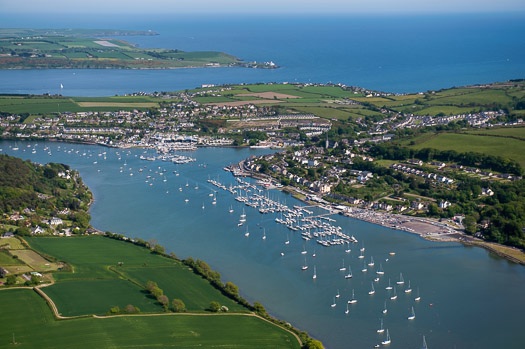 Crosshaven offers such a total package afloat and ashore, complete with a large ready-made home fleet, that smaller ports are at a disadvantage in competing to stage regattas. Photo: Bob Bateman
Crosshaven offers such a total package afloat and ashore, complete with a large ready-made home fleet, that smaller ports are at a disadvantage in competing to stage regattas. Photo: Bob Bateman
But that would be too totally at variance with ICRA's ethos of being a truly national body. And fortunately there is a let-out. Both the VLDR and Cork Week are held in July. The ICRA Nats have always been in either May or June. Thus although the Sovereigns Cup may be traditionally the last week of June, it's June nevertheless, and the basic integrity of the by-now traditional annual programme is maintained.
In the final analysis, it comes down the numbers game, and the Cork area and Dublin Bay start with an in-built advantage with their large fleets. In fact, Dun Laoghaire's enormous fleet puts it in a class of its own, and all sorts of special effects related to it being the harbour for a populous and burgeoning capital city come into play.
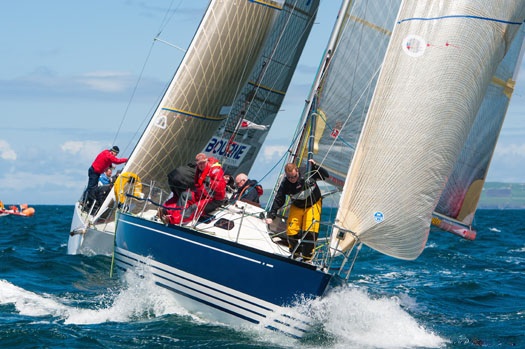 A brisk race, and back in time for tea – it's the way most cruiser-racers sail today. Photo: Bob Bateman
A brisk race, and back in time for tea – it's the way most cruiser-racers sail today. Photo: Bob Bateman
When everything falls into place, the numbers involved can be staggering. The increasing accuracy of weather forecasts plays a role in this. Last year, as the weather maps started looking a bit more healthy as the time for the four-day Volvo Dun Laoghaire approached, boats which had scarcely been racing at all were given a top and tail, they chatted their way through the late entry process, and crews were soon brought together for a sun-filled summer campaign in a record fleet.
It may sound a very hit and miss way to plan you sport, but that's the way we live now. Anyone in the hospitality industry in the West of Ireland can tell you that if there's a good forecast for the weekend, the Dubliners who can now reach them in a couple of hours on the motorway will be in contact, cutting last-minute deals. And if the weather's bad, those same Dubliners will either spend the weekend at home on indoor pursuits, or else they'll hightail to the airport to take up a late bargain on a day or two in the sun.
When volatility like that becomes the norm, management will have to be flexible or it will fail. Even in times past, "Surely you knew we'd be coming?" was a frequent greeting as some late un-entered would-be participant turned up at an Irish regatta. That said, if you're half serious about your racing, you'll have had it all – boats and crew alike - in place months in advance. But the latecomers will happily claim that such punctiliousness makes it even more galling when some bunch of hastily-assembled pierhead jumpers goes out and gets a good result.
Entries for the ICRA Nationals 2014 at the Royal Irish YC from June 13th to 15th went through the hundred mark this week when Darragh McCormack's Foynes-based J/24 Maximus became officially registered, and almost immediately afterwards Converting Machine from Pwllheli in North Wales came aboard, so progress towards the desired 120 is looking good.
That may seem optimistic with just four weeks to go, but Fintan Cairns of ICRA, who is monitoring the list and liaising with the RIYC, is a realist. Remembering what happened with the VLDR in the final days of countdown last year, he's keeping one eye on the met maps, and another on the current low entry in classes like the Sigma 33s and the First 211s. A bit nearer the time, and a cheerful weather prospect for mid-June will see those numbers coming to life.
That said, up at the sharp end, the serious entries have been in place for weeks, and it's already a cracker of a fleet. And even the most rugged traditionalist offshore racer who claims to enjoy nothing more than a 90 mile slug to windward will allow himself (or herself) to enjoy a bit of sunshine sailing in the bay.
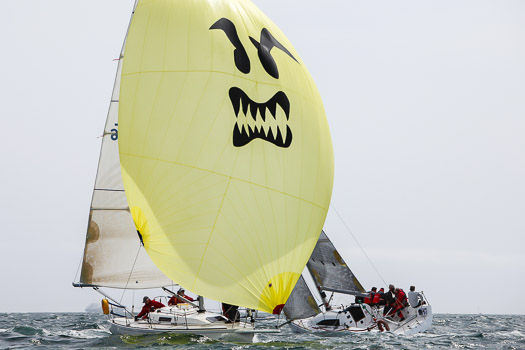 This sort of cruiser-racing is just the ticket for most crews – and they'd prefer not to be in an event which involves racing at night. Photo: Bob Bateman
This sort of cruiser-racing is just the ticket for most crews – and they'd prefer not to be in an event which involves racing at night. Photo: Bob Bateman
ICRA Drop Plans for New Cruiser Division
#cruiserracing – The Irish Cruiser Racing Association (ICRA) has dropped plans to create a new handicap division at the bottom end of class 1 and the top of class 2 for its IRC national championships at the Royal Irish Yacht Club (RIYC) next month, one of the biggest events of the Irish sailing calendar.
The ICRA event, that is aiming for a record entry of over 110 boats, is a handicap based regatta which means any decision affecting rating bands and in what class boats sail can be a contentious issue.
ICRA's handicapping chief Denis Kiely explained yesterday 'there wasn't enough interest/entries and while this is somewhat disappointing we have to work with what we have not what we would like to have'.
The turnaround means the championships will have a more traditional configuration of Divisions 0, 1, 2, 3, and 4 in spite of the class band shake–up that was hinted at November's annual conference.
The non-spinnaker boats [Corinthian Cup] will most likely be in 2 divisions and they will be numbered 5 and 6.
In an up date to skippers yesterday Kiely said arrangements are still provisional until remaining entries are in but it is very unlikely that the divisions configuration will change hereafter - individual boats at the margins may be a different matter.



























